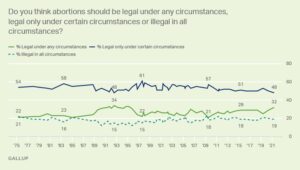Mulling the angst among Democrats over the continuing shrinkage of their FY 2022 budget reconciliation bill, I wrote at New York the not-so-distant time the opposition was in the same sport:
Democrats are in a state of agony over the possibility that their hard-earned governing trifecta, which is very likely to expire after the November midterm elections, will produce far less in the way of legislation than they had envisioned. And while there are, as my colleague Jonathan Chait put it, “a thousand fathers” for the disappointing end to the saga of the once-robust Build Back Better package, much of the blame for Democrats’ steadily shrinking agenda is being cast toward a tiny group of self-styled “centrists” led by West Virginia Senator Joe Manchin.
Democrats famously have a tendency to regard themselves as a party in disarray and are uniquely prone to letting down their activist base by underachievement. But the truth is that narrow congressional majorities often produce devastating legislative setbacks. Ask the Republicans who watched their own domestic policy Great White Whale, a repeal of Obamacare, go down the tubes in the wee hours of July 28, 2017. The coup de grâce was administered by the late John McCain, whose famous “thumbs-down” gesture signaling his decisive vote against the last-gasp “skinny repeal” bill became the symbol of Republican frustration (much like Manchin’s pronouncements against this or that Democratic priority today) in the 115th Congress.
But then as now, the failure was not so simple. Obamacare repeal — like the Build Back Better package, an initiative utilizing the filibuster-skirting budget reconciliation process — was beset by a host of problems. These ranged from hostage taking by Republican dissidents in both Houses who used their leverage over the bill to reshape and sometimes delay it; the nonnegotiable demands of the Senate parliamentarian who used the power to block inclusion of provisions that didn’t meet the obscure germaneness requirements of the Byrd Rule; intra-party factional fights over the scope and audacity of the legislation (which in most versions included explosive add-ons like a Medicaid spending cap); and nervous glances at polling with the upcoming midterm elections in mind. This should all sound familiar to those watching the Democratic dance over BBB.
Republicans in 2017 had the additional handicap of dealing with the most unpredictable president in recent memory, whose support for long-agreed-upon plans could never be taken for granted. And while some may think Democrats are uniquely devastated today because of the enormous possibilities that appeared to open up when their party took over the White House and the Senate in 2021 (with much debate as to whether FDR’s New Deal or LBJ’s Great Society blitz provided the best precedent), Republicans had their own sky-high expectations after winning a trifecta in 2016. As I wrote days after the 2016 election:
“With Trump in the White House and the GOP controlling Congress — the condition that will prevail in January, based on the results of Tuesday’s election — Republicans are now in a position to work a revolution in domestic policy. It will likely be at least as dramatic as anything we’ve seen since Ronald Reagan’s first year in office, and perhaps since LBJ and congressional Democrats enacted the Great Society legislation that is now in peril …
“[A]s Paul Ryan told us all in early October, he has long planned to use the budget reconciliation process — where there is no filibuster available in the Senate — to enact his entire budget in one bill. Again, a bill that cannot be filibustered. He referred to it, appropriately, as a bazooka in his pocket. And while there are some things you cannot do in a reconciliation bill, there aren’t many of them: Congressional Republicans did a trial run last year (nobody paid much attention, because they knew Barack Obama would veto it), and it aimed at crippling Obamacare, defunding Planned Parenthood, and disabling regulators, in addition to the nasty surprises for poor people mentioned above.”
Alarmist as this might sound in retrospect, it was realistic at the time … until Paul Ryan, Mitch McConnell, and Donald Trump found out how hard it was to rush through a budget reconciliation bill with narrow majorities in both Houses.
The analogy between each party’s recent struggles with passing a reconciliation bill is hardly precise, of course. In late 2017, Republicans would bounce back from repeated failed efforts to repeal Obamacare and use reconciliation to enact the very tax cuts that most (though crucially, not all) Democrats want to revise or repeal now. Then they lost control of the House (and thus their trifecta) in November 2018. In the case of today’s Democrats, they got their successful reconciliation bill earlier, in March 2021, in the form of the $1.9 trillion American Rescue Plan that combined COVID relief and recovery measures with small bites of Biden’s economic agenda. Because so much of it was keyed to the pandemic, it was easier to enact than the various long-term measures contemplated in the second planned reconciliation bill (Build Back Better), but its luster as an accomplishment has been diminished by claims that it contributed to the current inflation crisis.
So what’s the lesson for Democrats? The trouble they’ve had isn’t simply about their alleged disunity, or the president’s alleged lack of leadership, or even about the pernicious use of leverage by Manchin or others to throw sand into the legislative machinery. It all comes back to the shakiness of small congressional majorities, and the power of the Senate filibuster, and the creaky imperfections of the budget process as one of the few ways around around the filibuster. Institutional reforms are ultimately the only solution — and yes, Manchin is a huge obstacle to those as well — rather than some surgery on the soul of the Democratic donkey and its various limbs and organs.




